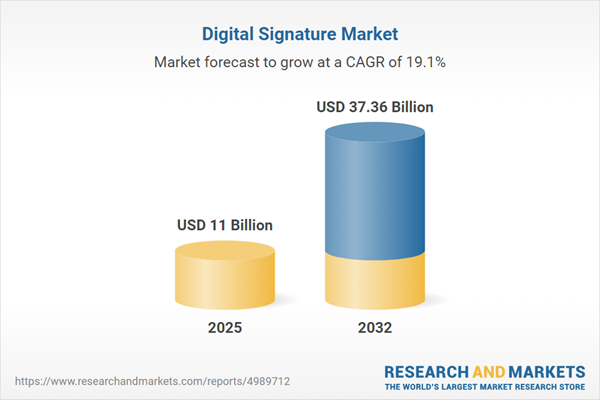Speak directly to the analyst to clarify any post sales queries you may have.
The digital signature market is rapidly advancing as organizations worldwide seek secure and efficient authentication solutions suited to evolving compliance requirements and operational demands. Amid emerging technologies and regulatory rigor, digital signatures are becoming essential for business resilience and seamless workflows.
Market Snapshot: Digital Signature Market Size and Growth Outlook
The Digital Signature Market grew from USD 9.22 billion in 2024 to USD 11.00 billion in 2025. It is expected to continue growing at a CAGR of 19.10%, reaching USD 37.36 billion by 2032.
Scope & Segmentation
- Type: Advanced Electronic Signatures, Qualified Electronic Signatures, Simple Electronic Signatures
- Components: Hardware, Services (Consulting, Integration & Deployment, Support & Maintenance), Software (Cloud-Based, On-Premise)
- Key Type: Private Key, Public Key
- Organization Size: Large Enterprises, Small & Medium Enterprises
- End-User: Aerospace & Defense, Banking, Financial Services & Insurance (BFSI), Building & Construction, Consumer Goods, Education, Energy & Utilities, Government & Public, Healthcare & Life Sciences, Legal, Manufacturing, Real Estate, Retail & eCommerce, Telecommunication & IT
- Region: Americas (North America, Latin America), Europe, Middle East & Africa, Asia-Pacific
Extensive segment coverage enables focus on industry-specific adoption drivers, regulatory influences, and technology integration across diverse organizational profiles and methodologies.
Key Takeaways: Strategic Insights for Decision-Makers
- Adoption is catalyzed by widespread digitization and regulatory shifts, compelling organizations to modernize their document approval and transaction processes.
- Emerging encryption methods, biometric authentication, and seamless API integration are actively redefining authentication workflows, enhancing data integrity and operational efficiency.
- Provider ecosystems are expanding through partnerships, strategic acquisitions, and deep software integrations, embedding digital signing into enterprise platforms and sector-specific applications.
- Cloud-first strategies are accelerating, as many organizations prefer cloud-hosted solutions for agility, while regulated sectors balance cloud and on-premise deployments to address data sovereignty.
- User experience remains a core focus, with platforms prioritizing intuitive design, mobile accessibility, and interoperability with business-critical systems.
- Global adoption patterns are strongly influenced by regulatory harmonization in Europe, digitization programs in the Americas, identity initiatives in the Middle East and Africa, and strategic partnerships across Asia-Pacific.
Tariff Impact: Navigating Trade Policy Changes in 2025
United States tariff adjustments in 2025 added complexity to global supply chains for digital signature solutions. Hardware components, such as tokens and biometric devices, face higher import duties, impacting procurement and spurring alternative sourcing strategies. Indirect pricing effects on software and integration services have encouraged enterprises to explore cloud-native technology, reduce hardware reliance, and consider hybrid deployments for cost efficiency and risk resilience.
Methodology & Data Sources
This analysis combines in-depth secondary research, structured interviews with senior stakeholders, and validation through industry case studies and regulatory documentation. Peer review ensures all insights are accurate, comprehensive, and actionable for commercial strategy.
Why This Report Matters
- Gain clarity on how technological advancements, regulatory standards, and user experience are converging to shape market opportunities and threats.
- Identify region-specific drivers and challenges to effectively inform expansion planning and risk management initiatives.
- Benchmark competitive strategies and technology choices, aiding in robust procurement and investment decisions for future-proofing operations.
Conclusion
The digital signature market presents compelling avenues for organizations to enhance security, efficiency, and compliance. Strategic adaptation and informed decision-making will empower industry leaders to leverage digital signing as a foundation for modern, secure business operations.
Additional Product Information:
- Purchase of this report includes 1 year online access with quarterly updates.
- This report can be updated on request. Please contact our Customer Experience team using the Ask a Question widget on our website.
Table of Contents
3. Executive Summary
4. Market Overview
7. Cumulative Impact of Artificial Intelligence 2025
Companies Mentioned
The companies profiled in this Digital Signature market report include:- Actalis S.p.A.
- Adobe Systems, Inc.
- airSlate Inc.
- AlphaTrust Corporation by iPipeline, Inc.
- Altron Limited
- Ascertia by InfoCert S.p.A.
- Box, Inc.
- Citrix Systems, Inc. by Cloud Software Group, Inc.
- Conclude (Pty) Ltd.
- DigiCert, Inc.
- Docstribute Limited
- DocuSign, Inc.
- Dropbox, Inc.
- EDICOM Global
- eMudhra Limited
- Entrust Corporation
- GMO Internet Group, Inc.
- Google LLC by Alphabet Inc.
- HID Global Corporation
- Impression Signatures
- International Business Machines Corporation
- Kyocera Corporation
- Microsoft Corporation
- Notarius Inc. by Portage CyberTech Inc.
- OneSpan Inc.
- PandaDoc Inc.
- PaperTrail by Egis Software
- Ricoh Company, Ltd.
- RPost Technologies
- Secured Signing, Inc.
- Signatura
- Signaturit Solutions, S.L.
- SigniFlow
- SIGNiX, Inc.
- Signority Inc.
- Skribble AG
- Symtrax Holdings, Inc.
- Thales Group
- Trust Factory
- Tungsten Automation Corporation
- VÍNTEGRIS, S.L.
- Zoho Corporation Pvt. Ltd.
Table Information
| Report Attribute | Details |
|---|---|
| No. of Pages | 197 |
| Published | November 2025 |
| Forecast Period | 2025 - 2032 |
| Estimated Market Value ( USD | $ 11 Billion |
| Forecasted Market Value ( USD | $ 37.36 Billion |
| Compound Annual Growth Rate | 19.1% |
| Regions Covered | Global |
| No. of Companies Mentioned | 43 |









